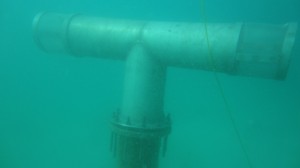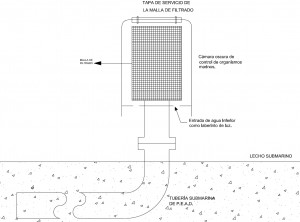Background.
When it is required to capture water from the sea to feed a desalination plant, there is a need to filter the water entering the underwater pipeline, in order to prevent animals from entering and algae into the water system. Generally these structures consist of simple filtering meshes with sufficient catchment area, allowing water to enter a low standard rate, to prevent small bodies being sucked inside.
The main problem presented by these structures, once put into operation, lies in the maintenance of the strainer to be often scraped to remove the biological material growth on its surface. This situation is compounded when the coaptation depth is small, as to be greater illumination increases the growth of organisms, considered an area of high biological activity. Therefore, it may require having to make frequent maintenance to clean the strainer.
Benefits.
This design provides a filter operation takes unobstructed submarine involving constant maintenance for cleaning. It also allows him, simply, reviewing physical condition of the mesh filter and the inner walls of the filter structure with the use of a minimum dive staff..
Basic Principles.
The proposed design for the filter takes is to achieve water inlet filter mesh without its interior from light. This is intended to mimic similar to an underwater cave, where water flows freely but life inside its walls is sparse environment, being an environment of low biological activity.
Design forms can be varied according to the specific conditions of each project, but in this paper we propose an outline of a submarine outlet filter with lighting control, simple but meets the following design principles:
- Capture water from the bottom of the intake structure as the light comes from the filter surface and thus prevents direct light inside.
- Create a maze to the passage of light that creates a dark atmosphere around the Mayan filtering.
- Paint the inside of the camera obscura in black, and the surface of the labyrinth of light, to avoid reflection of what little light can sneak inside.
- Section passage of water through the maze of light must be greater than or at least equal to the catchment area of the mesh filter. In order not to increase the input speed to avoid suction filter and small organisms into.
- You must have a service lid easily removed in order to check the status of the strainer and the inner surface of the camera obscura.
Take filter scheme with lighting control:
Recommendations
Author: Ing. Sergio Elena Romero. Empresa Elinsubca
Fecha: 15 de octubre de 2012

















me parece muy interesante tu información, lo que no puedo entender es ¿ cuál sería la velocidad necesaria del agua de entrada para evitar la incrustaciones en las paredes de los conductos de agua.
gracias.
Hola amigo, agradecemos tu interés en el artículo publicado, en respuesta a tu pregunta te indico que en nuestra experiencia de instalaciones de tuberías para tomas submarinas en material de polietileno de alta densidad, no ha sido relevante el problema de incrustaciones internas. Es siempre conveniente mantener una velocidad hidráulica recomendada para el transporte del agua dentro de una tubería (por ejemplo de: 1 -2 m/s, dependiendo del diámetro). Sin embargo, en el punto de captación submarina (donde se ubica el filtro toma) se debe aumentar el área de filtrado para disminuir la velocidad de entrada al filtro, de tal manera que no se succionen al interior pequeños animales, e incluso algas o sedimentos. La recomendación por norma internacional es no excederse de las velocidades de corriente típicas de la zona de filtrado, los fabricantes de estos sistemas usualmente manejan velocidades entre 0,15 – 0,18 m/s.
Agradecemos si nos envías tu correo electrónico a info@elinsubca.com, para incorporarte en nuestra base de datos para próximos envíos de artículos técnicos.
Muy interesante su diseño, es lo único que he conseguido al respecto. Me podrían decir cual es el diámetro de los orificios de la malla que ustedes consideran apropiado para este tipo de instalación? así como el tipo de material? gracias por su aporte
Hola amigo! Gracias por tu comentario. En respuesta a tu pregunta, hemos diseñado filtros obteniendo buenos resultados usando Acero Inoxidable 316L, con tela Mesh Nº 7 (3 mm) del mismo material. Cualquier duda, estamos para ayudarle. Saludos.
Me parece interesante, en mi caso tenemos una profundida minima de 10m en el mar, necesitamos bombear 1500m3/h con dos bombas verticales (750m3/h cada una), podemos usar este sistema?
Estimado Sr. Gerardo Sandoval, su solicitud ha sido contestada a través de su correo personal. Mucchas gracias.
Muy inteligente el diseño, sigan haciendo tan buen trabajo.
Gracias!